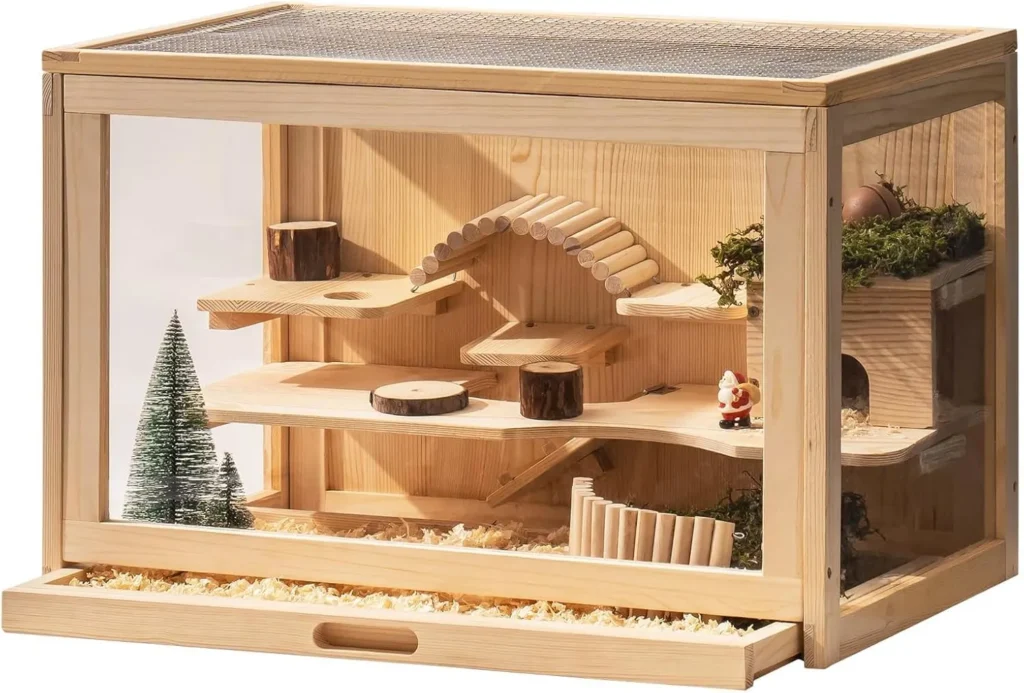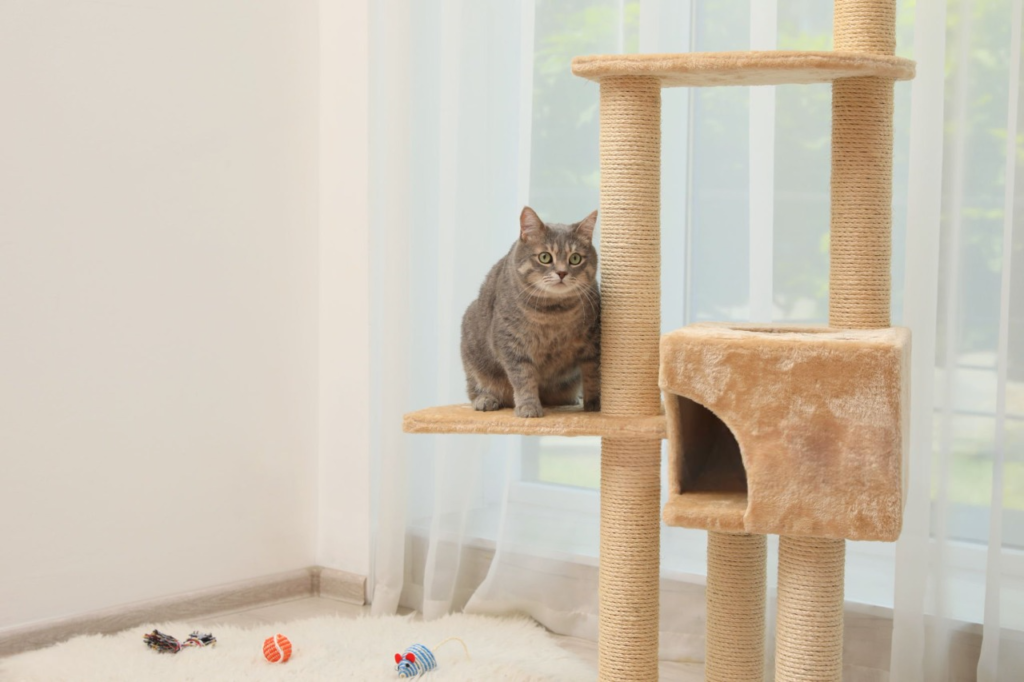Owning a hamster is a rewarding experience, and providing them with a spacious, safe, and stimulating environment is essential for their well-being. While store-bought cages can be expensive and often lack adequate space, a DIY hamster cage is a cost-effective and customizable alternative. This guide will walk you through the process of building your own homemade hamster cage using a large plastic bin, ensuring your pet has a comfortable and enriching home.
Why Choose a DIY Hamster Cage?
Many commercial hamster cages are too small, lacking proper floor space for running and burrowing. A DIY hamster home allows you to:
- Customize the size to suit your hamster’s needs
- Save money compared to buying expensive cages
- Ensure proper ventilation and hygiene
- Create an enriching environment with space for burrowing, toys, and accessories
Materials Needed
To create a DIY bin hamster cage, you will need:
- A large plastic storage bin (minimum 40 x 17.5 inches for dwarf hamsters, 40 x 22.5 inches for Syrian hamsters)
- Wire mesh for ventilation (¼-inch spacing recommended)
- Zip ties or bolts
- Box cutter or Dremel tool
- Drill with a small bit
- Wire cutters
- Sandpaper (to smooth cut edges)
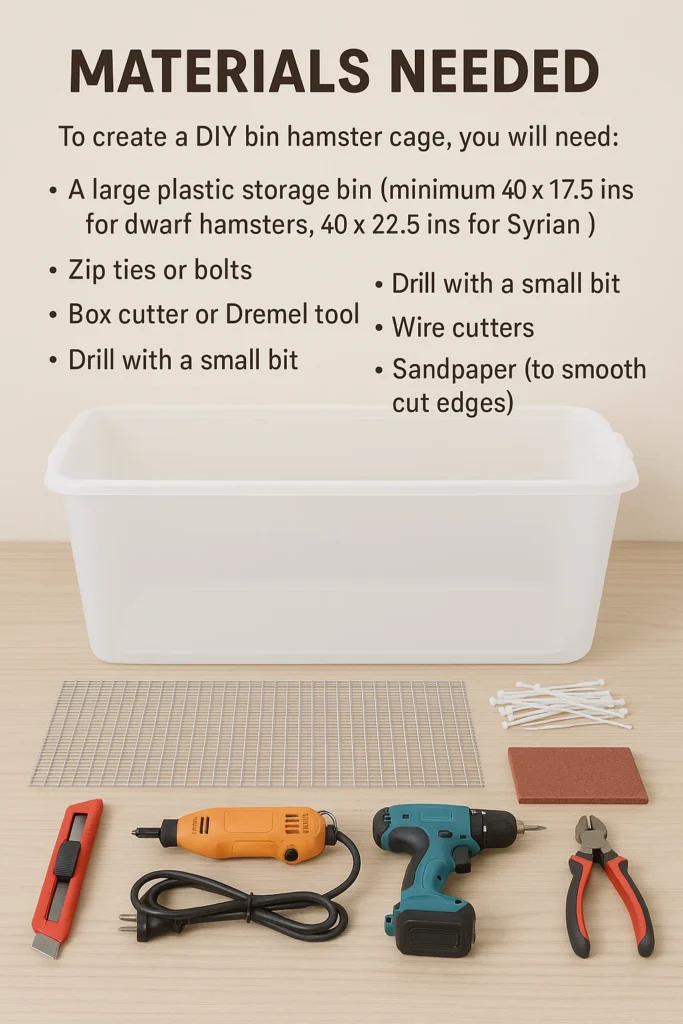
Building a cage yourself allows customization and cost savings for hamster owners. For those exploring small pets, check out our article on the Best Mouse Breeds for Pets.
Can a Hamster Live in a Plastic Box?
Yes, hamsters can live in a plastic bin cage if it is modified to allow proper ventilation and is spacious enough for their needs. This is a popular option for a hamster cage DIY IKEA hack, as many hamster owners repurpose large IKEA storage bins to create the perfect DIY hamster cage IKEA setup.
Step-by-Step Instructions
Step 1: Choosing the Right Bin
Select a clear or semi-clear plastic storage bin that is at least 24 inches tall to accommodate bedding and accessories. A deeper bin prevents escape and allows for proper burrowing depth.
Step 2: Cutting the Ventilation Window
- Mark a rectangular area on the bin lid where the ventilation panel will be placed.
- Use a box cutter or Dremel tool to carefully cut out the marked section.
- Sand the edges to prevent sharp spots that may harm your hamster.
Step 3: Installing the Wire Mesh
- Cut the wire mesh to fit the opening on the lid.
- Drill small holes about one inch apart along the edge of the cutout.
- Attach the mesh using zip ties or bolts to secure it in place.
Step 4: Adding Additional Ventilation (Optional)
If desired, create additional ventilation by cutting small sections on the sides of the bin and covering them with wire mesh in the same manner as the lid.
Step 5: Setting Up the Cage
Now that your hamster bin cage is built, it’s time to furnish it with essential items:
- Bedding: Provide at least 6–10 inches of bedding for burrowing (aspen, paper-based, or hemp bedding recommended).
- Food & Water: Use a sturdy bowl and a hanging water bottle.
- Hideouts: Include hamster DIY house options like ceramic, wooden, or cardboard hideouts for your hamster to sleep in.
- Exercise Wheel: Ensure the wheel is at least 8 inches for dwarf hamsters and 12 inches for Syrians. A hamster wheel DIY option can be made using household materials if necessary.
- Tunnels & Enrichment: Add natural materials like cork logs, hay tunnels, and wooden bridges to keep your hamster entertained.
- Sand Bath: Provide a shallow dish with reptile or play sand for natural grooming.
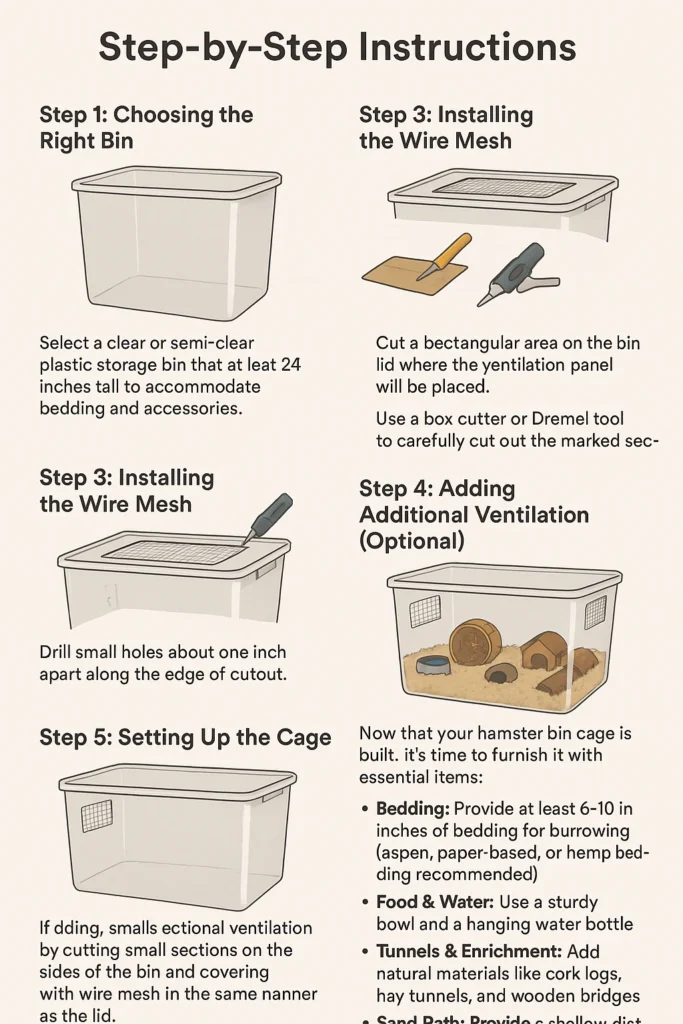
How to Make Easy Hamster Toys?
Hamsters love to play, and making homemade toys is a great way to keep them entertained. Here are some hamster DIYs to try:
- Cardboard Tubes: Use toilet paper or paper towel rolls to create tunnels.
- Egg Carton Hideout: Cut small holes in an egg carton for a fun hideaway.
- Popsicle Stick Bridges: Glue popsicle sticks together to create bridges or ramps.
- Digging Box: Fill a small container with shredded paper or hay for your hamster to explore.
How to Design a Hamster Cage?
When setting up your DIY hamster house, consider the following:
- Space: Provide plenty of floor space for movement.
- Levels: Platforms add variety to your hamster’s environment.
- Hiding Spots: Multiple hideouts make your hamster feel safe.
- Tunnels: Encourage natural burrowing behavior.
- Chew Toys: Essential for dental health.
Are Crittertrail Cages Bad for Hamsters?
The popular Crittertrail cages are not recommended for hamsters because they are too small. They also lack adequate floor space for running around, and the running wheel is too small for bigger hamster species such as the Syrian hamster, which could contribute to back injuries. The connecting tubes have multiple connection joints that can trap bacteria from the typical soiling that happens while the hamster is roaming the trails. This can act as a breeding ground for fecal bacteria as well as ammonia gas from urine.
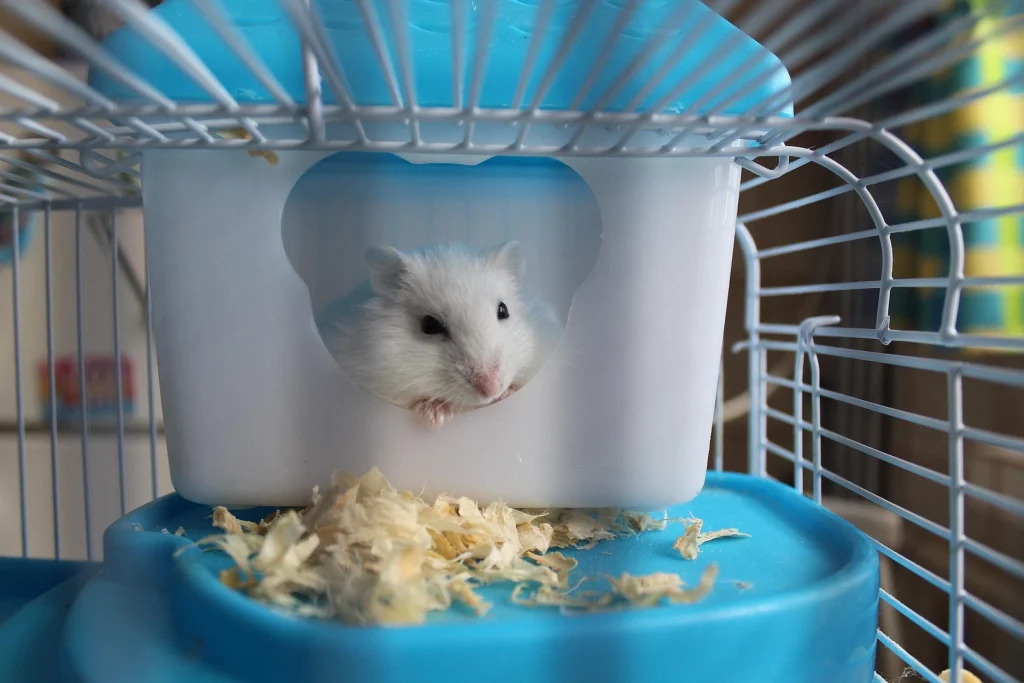
Hamster Cage Enrichment
Provide enrichment throughout your hamster’s cage by mimicking materials found in the wild, including:
Forage and enrichment foods
Sprinkle a hamster’s diet over the enclosure bottom instead of limiting to a food bowl. Place fruits and vegetables on a treat stick to make them more challenging to eat. Provide a variety of safe herbs, leaves, and flowers to eat on a weekly basis. Offer dried plants and seeds in sprays, including millet, flax, wheat, oat, quinoa, and sorghum (occasional), to mimic the food gathering encountered in the wild.
Deep bedding for burrowing
At least 10 inches of bedding is ideal for large hamsters. This will allow the hamster to imitate the burrowing behavior in the wild. Certain bedding materials such as aspen flakes, hemp shavings, and Care Fresh may not allow proper tunnels to hold up. Adding soft hay layers in between bedding layers may help the tunnel stability. It is also important to compact the bedding to help with stability.
Make sure to provide bedding in a large enough area of the enclosure or entire floor. Adding a cork log or other tunnel halfway into the bedding can be a starting point for a burrow system. It may take some hamsters time to figure out that they enjoy this behavior.
Different materials to touch and dig in
Provide a dig box with either corn cob bedding (watch for signs of ingestion and remove if seen), coconut fiber, cork granules, beech chips, or pillow moss/sphagnum moss
Sand bath
Sand is used for grooming, digging, rolling, or some hamsters will use it as a litter box. Avoid using dust and powder substrates. Chinchilla sand is too dusty. It is best to use play sand or reptile sand with no added dyes or calcium. Be sure to avoid dollar store or craft store sand. Make the enclosure big enough to dig and roll in such as a glass baking dish. Something with a lip or cover may be good for hiding under.
Tubes and branches
Tubes and branches are used to hide in or under. Examples of these are cork log and grape vine wood. Each piece is unique and natural, textured to help keep hamster nails trim. These can be found in the reptile section of pet stores. Other common items include bamboo root, birch tubes, and terracotta tubes.
Platforms
Provide a shelf for heavy items so hamsters can hide underneath. These must be at least 3 inches high for a dwarf hamster or up to 6 inches for Syrian hamsters to comfortably fit underneath.
Hideouts
Offer a basket, ceramic, or wood cubby for hiding. Fill your hamster’s cage so that it is semi-crowded to help them feel safe and protected. This can be accomplished with multiples of items made of wood, terracotta clay, ceramic, and cardboard. Avoid items that contain nails or are made of soft wood or hide that may leak resin. Make sure that the entrance is big enough—2 inches (dwarf) or 3 inches (Syrian). A multi-chamber hideout can also be purchased or made from scratch.
Hamster Cages FAQs
Can You Put a Hamster in a Cage?
Yes, but the cage should be large enough (minimum 450 square inches) and enriched with bedding, food, water, toys, and hiding places.
Is It Safe to Hold a Hamster?
Yes, but handle them gently and allow them to get used to your scent first.
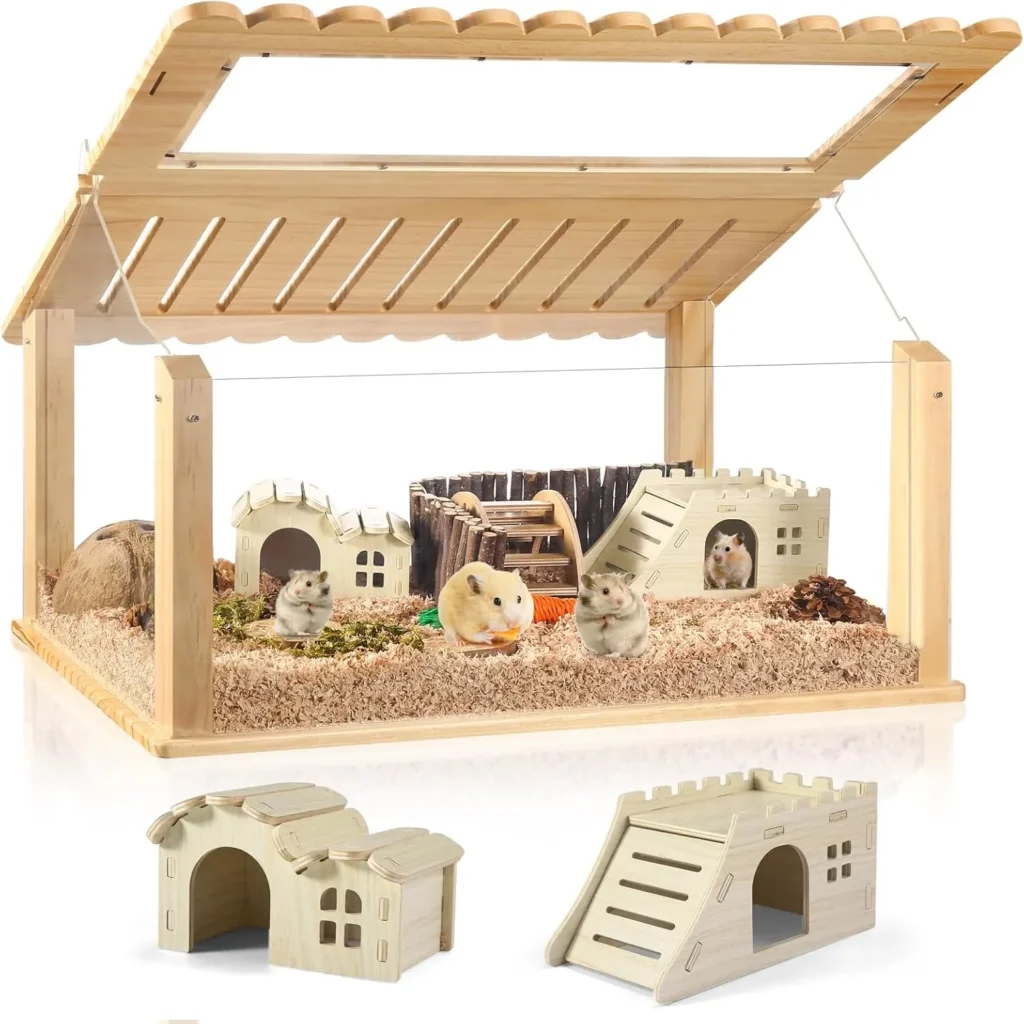
What is better for a hamster—cage or tank?
A tank is better as this allows more substrate and bedding to be provided for burrowing and digging.
What is the best cage for a Syrian hamster?
A Syrian hamster requires a cage with a mesh or wire top (1/2 in or less spacing) and deep plastic or glass tank style bottom that is 40 x 22.5 inches to allow at least 10 inches of bedding.
What is the best cage for a Dwarf hamster?
A dwarf hamster needs a similar cage that measures 40 x 17.5 inches with 6-8 inches of bedding.
How to Tame a Hamster?
Start by offering treats from your hand and speaking softly. Let them come to you rather than forcing interaction.
Why Did My Hamster Bite Me?
Hamsters may bite if they feel threatened, startled, or if your hands smell like food.
Is It Easy to Pet a Hamster?
Yes, but they require patience, gentle handling, and regular interaction.
What Fruit Can Hamsters Eat?
Safe fruits include apples (without seeds), bananas, strawberries, and blueberries. Avoid citrus fruits as they are too acidic.
A good cage setup includes dust baths for species like chinchillas. Learn what kind to use in Best Chinchilla Dust.
Conclusio
A DIY hamster cage is a fantastic way to provide your furry friend with a spacious, safe, and enriching environment. By using a plastic bin, wire mesh, and simple tools, you can create a customized homemade hamster cage that meets your hamster’s needs while saving money. With proper care and enrichment, your hamster will thrive in their DIY hamster home!
Would you like to add any unique features or personalization to your DIY IKEA hamster cage? Let us know in the comments!
